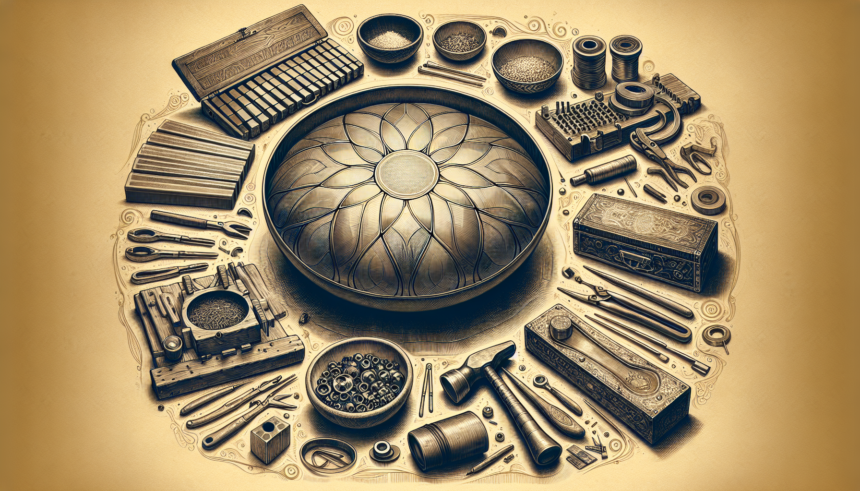Handpans, with their ethereal tones and mesmerizing design, have captured the interest of musicians and enthusiasts around the world. These instruments are a blend of art and engineering, and the choice of materials used in their construction significantly impacts their sound quality, durability, and overall aesthetics. This article delves into the various materials used in handpan construction and their unique properties.
Steel: The Traditional Choice
The majority of handpans are made from steel, and for good reason. Steel offers a great balance between durability, resonance, and workability, making it a versatile material for instrument makers. There are primarily two types of steel used in handpan construction:
1. Nitrided Steel
Nitrided steel is treated with nitrogen to create a hardened surface. This process enhances the steel’s resistance to wear and corrosion, making the handpan more durable. Nitrided steel handpans often produce a bright, clear tone, favored by many professional players. The nitrogen treatment also helps in stabilizing the tuning, providing a consistent sound over time.
2. Stainless Steel
Stainless steel handpans are known for their rich, warm tones. These instruments often have a more mellow and sustained sound compared to nitrided steel handpans. Stainless steel is highly resistant to rust and corrosion, which makes these handpans particularly appealing for outdoor performances and long-term durability. However, they can be more challenging to tune and require precision craftsmanship.
Alternative Metals: Exploring New Horizons
While steel is the most common material, handpan makers are always exploring new materials to push the boundaries of the instrument’s sonic capabilities. Here are a few alternative metals that have been experimented with:
1. Brass
Brass, an alloy of copper and zinc, is known for its bright and vibrant sound. Handpans made from brass can produce a unique tonal quality that stands out from traditional steel handpans. However, brass is softer than steel, making it more susceptible to dents and damage. This material also requires more maintenance to keep it in good condition, including regular polishing to prevent tarnish.
2. Bronze
Bronze, primarily composed of copper and tin, offers a warm, resonant sound with a rich harmonic spectrum. It is a durable material that has been used for centuries in various musical instruments and sculptures. The drawback of bronze is its weight; it is considerably heavier than steel, which can affect the portability of the handpan.
3. Aluminum
Aluminum is lightweight and resistant to corrosion, making it an attractive option for handpan makers looking for a portable and durable material. Handpans made from aluminum have a distinct, clear tone. However, aluminum’s lightweight nature can sometimes result in a less robust sound compared to steel or bronze handpans.
Innovative Approaches: Composite Materials
Recent advancements in material science have introduced composite materials into handpan construction. These materials combine different elements to create a hybrid with enhanced properties. One notable example is carbon fiber, known for its strength-to-weight ratio and durability.
Carbon Fiber
Carbon fiber composites offer exceptional durability and minimal weight. Handpans made from carbon fiber are incredibly resilient to physical damage and environmental factors. They can produce a wide range of tones, from bright and crisp to warm and mellow, depending on the specific construction techniques used. However, carbon fiber handpans can be expensive due to the high cost of materials and the precision required in their manufacturing.
Comparing Sound Characteristics
The material of a handpan greatly influences its sound characteristics. Here is a comparative overview of the sonic properties of different materials:
- Nitrided Steel: Bright, clear tones with good sustain and resonance. Stable tuning and durable.
- Stainless Steel: Warm, rich tones with a mellow and sustained sound. Highly resistant to corrosion.
- Brass: Bright and vibrant sound but susceptible to damage and requires maintenance.
- Bronze: Warm and resonant sound with a rich harmonic spectrum but heavy.
- Aluminum: Lightweight with a distinct, clear tone, but less robust sound.
- Composite Materials (Carbon Fiber): Wide range of tones with exceptional durability, though expensive.
Factors Influencing Material Choice
Choosing the right material for a handpan involves balancing several factors, including:
1. Sound Preferences
The tonal quality desired by the player is paramount. Different materials produce distinct sounds, so the choice depends largely on the preferred musical expression.
2. Durability
Handpans are often played with hands and fingers, which means they need to withstand regular physical contact. Durability is a key consideration, especially for those who travel frequently with their instruments.
3. Maintenance
Some materials require more upkeep than others. For instance, brass needs regular polishing to maintain its appearance, while stainless steel requires minimal maintenance. Players need to consider how much effort they are willing to invest in maintaining their instrument.
4. Cost
Different materials come with different costs. While carbon fiber offers many benefits, it is often more expensive than traditional steel options. Budget constraints can significantly impact the material choice.
5. Craftsmanship
The skill and experience of the handpan maker also play a crucial role. Some materials are more challenging to work with and require specialized knowledge and tools to shape and tune correctly.
Conclusion
The world of handpan construction is rich with material choices, each offering unique benefits and challenges. From the traditional nitrided and stainless steels to the innovative carbon fiber composites, the material used in a handpan significantly influences its sound, durability, and overall experience. Musicians need to consider their personal preferences for sound, the level of maintenance they are comfortable with, their budget, and the craftsmanship involved in the handpan’s construction. By understanding these factors, players can select the ideal material that resonates with their musical journey.
FAQs
1. What is the most common material for handpans?
Steel is the most common material used for handpans, with nitrided and stainless steel being the most popular types. Steel provides a good balance of durability, resonance, and workability.
2. How does the material affect the sound of a handpan?
The material of a handpan significantly affects its sound. For instance, nitrided steel offers bright, clear tones, while stainless steel provides warm, rich tones. Alternative materials like brass and bronze also produce unique sound qualities.
3. Are carbon fiber handpans better than steel handpans?
Carbon fiber handpans offer exceptional durability and a wide range of tonal possibilities, but they are often more expensive. Whether they are “better” depends on personal preferences for sound and budget considerations.
4. What are the maintenance requirements for different handpan materials?
Maintenance varies by material. Brass handpans require regular polishing to prevent tarnish, while stainless steel handpans are more resistant to corrosion and need less upkeep. Each material has its specific maintenance needs.
5. Can alternative materials like brass or bronze rival the sound quality of steel handpans?
Alternative materials like brass and bronze can produce unique and appealing sound qualities. While they may offer different tonal characteristics compared to steel, whether they rival steel handpans depends on individual sound preferences.





